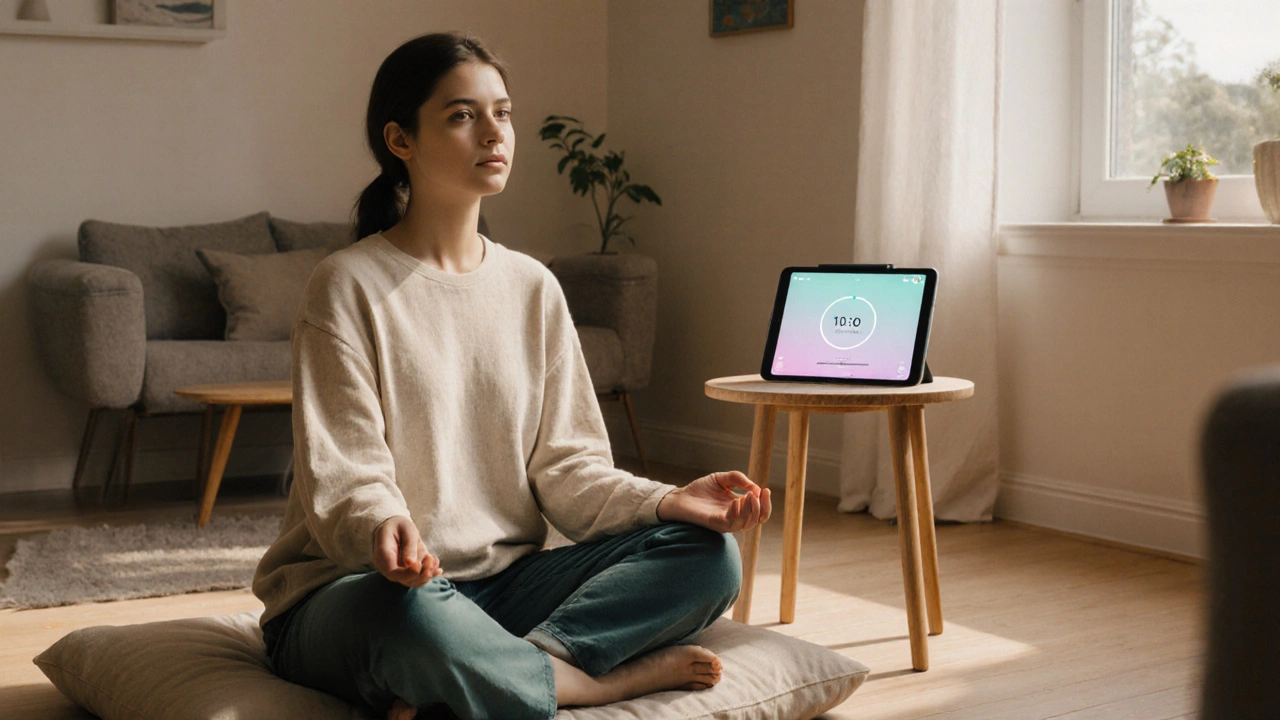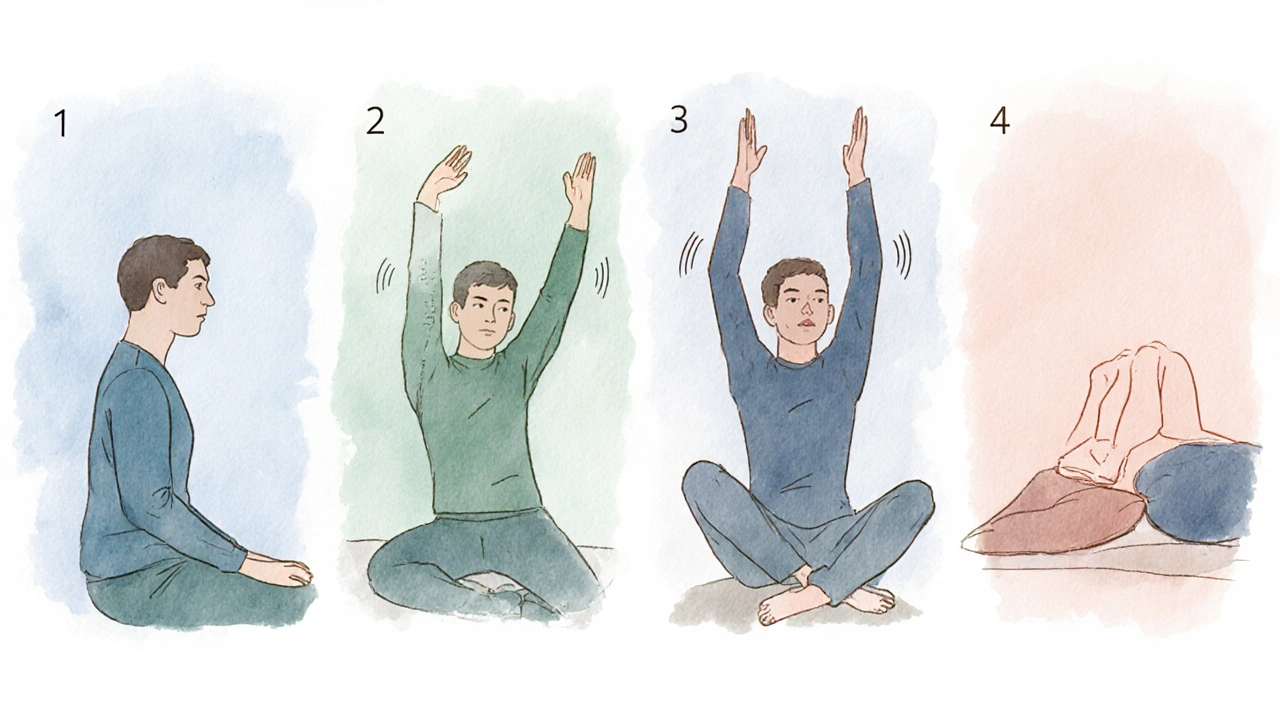Breema for Stress Relief: Essential Practice Guide
 Oct, 5 2025
Oct, 5 2025
Breema Practice Timer
Breema Practice Timer
Follow along with the 10-minute Breema starter routine. Each step has a timer to help you maintain the correct pace and mindfulness.
Step 1: Breathing Technique
Simple diaphragmatic breaths. Inhale for 4 counts, pause 2, exhale for 6. Repeat three times.
Step 2: Open-Close Arm Movement
Raise arms overhead on inhale, lower slowly on exhale. Perform three cycles.
Step 3: Seated Twist
Sit tall, twist gently for 30 seconds on each side.
Step 4: Leg Release
Lie on back, lift hips a few centimeters, lower slowly. Repeat five times.
Practice Complete!
Great job! You've completed your Breema session. Notice any changes in your breathing, tension, or mental clarity.
- Time spent: 0 min
- Steps completed: 0
- Feedback: You're doing great!
Quick Takeaways
- Breema uses slow, intentional movements and breath to calm the nervous system.
- Only 10‑15 minutes a day can lower heart rate and ease muscle tension.
- No special equipment or yoga mat is required - you can practice on a chair or floor.
- Combining Breema with basic mindfulness amplifies stress‑reduction benefits.
- Beginners often feel noticeable relaxation after the first session.
When it comes to Breema is a gentle, intuitive bodywork practice that blends slow, rhythmic movements with focused breathing to promote relaxation and body awareness, many people discover a surprisingly quick way to melt away stress.
Stress reduction refers to techniques that lower the physiological and mental impact of stressors, often measured by heart‑rate variability, cortisol levels, or perceived tension is a top priority for busy professionals, parents, and anyone juggling multiple responsibilities. Traditional options like yoga or meditation work, but they can feel intimidating or time‑heavy. Breema offers a middle ground: a practice that feels natural, requires almost no gear, and can be slipped into a coffee break.
How Breema Works: The Core Mechanics
The magic lies in three simple pillars:
- Slow, intentional movement - each pose is held for 30-60 seconds, allowing muscles to release gradually.
- Breathing coordination - you inhale as you open, exhale as you close, syncing breath with motion.
- Mindful attention - you focus on the sensations in the body, which quiets the mind.
These pillars directly engage the autonomic nervous system the part of the nervous system that controls involuntary functions like heart rate and digestion. By activating the parasympathetic branch (the "rest‑and‑digest" side), Breema nudges the body away from the fight‑or‑flight response.
Step‑by‑Step Starter Routine (10‑15 Minutes)
Find a quiet spot where you can sit or lie down comfortably. You’ll need only a cushion or chair.
- Begin with breathing techniques simple diaphragmatic breaths that expand the belly on inhale and contract on exhale. Inhale for 4 counts, pause 2, exhale for 6. Repeat three times.
- Do the "Open‑Close Arm" movement: raise both arms overhead on an inhale, keep shoulders relaxed, then lower them slowly on an exhale. Perform three cycles, feeling the stretch in your shoulders and upper back.
- Transition to "Seated Twist": sit tall, place your right hand on the left knee, inhale to lengthen the spine, exhale to gently twist left. Hold for 30 seconds, breathe naturally, then switch sides.
- Finish with "Leg Release": lie on your back, bend knees, place feet flat on the floor. Inhale to lift hips a few centimeters, exhale to lower. Repeat five times, focusing on the release of muscle tension the tightness that builds up in muscles after stress or poor posture.
When you finish, notice any changes in your heart rate, breathing depth, or mental chatter. Most beginners report a calmer mind within minutes.
Why Breema Beats Common Alternatives for Busy Schedules
Below is a quick comparison of Breema, yoga, and tai chi-three popular mind‑body practices often recommended for stress relief.
| Aspect | Breema | Yoga | Tai Chi |
|---|---|---|---|
| Movement speed | Very slow, held | Varies (slow to vigorous) | Slow, flowing |
| Focus required | Light mindfulness | Often deeper meditative focus | Mindful flow |
| Equipment | None (chair or cushion) | Mat, blocks optional | None |
| Beginner friendliness | High - no poses to master | Medium - some poses need flexibility | Medium - learning sequences takes time |
| Stress‑relief rating* | 8/10 | 7/10 | 7/10 |
*Based on user surveys from 2023‑2024 that measured perceived stress after a single 15‑minute session.
For someone who can’t commit to a full class, Breema’s minimal setup and short duration make it a practical choice.

Integrating Breema Into Everyday Life
Consistency beats intensity. Here are three realistic ways to weave Breema into a typical day:
- Morning wake‑up: After brushing your teeth, do the "Open‑Close Arm" for 2 minutes while the coffee brews.
- Work break: Stand up at your desk, place a chair against the wall, and perform the "Seated Twist" for a quick reset.
- Evening wind‑down: While watching TV, lie on a couch and run the "Leg Release" sequence to soften any lingering tension.
Each mini‑session contributes to what researchers call body awareness the conscious perception of physical sensations, posture, and movement patterns. Heightened body awareness helps you notice stress signs early-tight shoulders, shallow breathing-so you can intervene before the pressure builds.
Common Pitfalls and How to Avoid Them
Even simple practices can go sideways if you’re not careful. Watch out for these traps:
- Rushing the movements. If you glide quickly, you lose the parasympathetic activation. Set a timer for each hold.
- Holding your breath. The breath is the bridge between mind and body. Keep a soft inhale‑exhale cycle throughout.
- Doing it on a hard surface. A thin mat or cushion protects joints and encourages relaxation.
- Skipping the mindfulness check‑in. After each pose, pause for a second and notice any shift in tension or mood.
Correcting these habits boosts the stress reduction effectiveness of a practice in lowering cortisol, heart rate, and perceived anxiety impact by up to 30% according to a 2022 field study of office workers.
Progress Tracking: Simple Metrics That Matter
You don’t need a fancy app to see results. Pick two or three of these easy-to‑measure signs:
- Heart‑rate variability (HRV): If you have a smartwatch, note the nightly HRV before and after a month of daily Breema.
- Sleep quality: Rate how rested you feel each morning on a 1‑5 scale.
- Self‑reported tension: Keep a short journal noting neck or back stiffness at the end of each day.
When you see consistent improvement, the habit sticks. If numbers plateau, try adding a new Breema sequence or extending each hold by 10 seconds.
Getting Started: Resources and Next Steps
To dive in, you’ll need a reliable guide. Look for:
- A beginner’s DVD or streaming series that walks through each movement slowly.
- Local workshops-many community centers offer a free introductory hour.
- Online forums where practitioners share tips and answer questions.
Remember, the goal isn’t mastery; it’s relief. Even a single 10‑minute session can shift your nervous system from stress to calm.
Frequently Asked Questions
How often should I practice Breema for noticeable stress relief?
Three to five short sessions per week are enough for most people. Consistency matters more than duration; even 5‑minute bursts can lower cortisol if done regularly.
Can I combine Breema with other stress‑relief practices?
Absolutely. Many users pair Breema with meditation, progressive muscle relaxation, or a short walk. Just keep the total daily time realistic to avoid burnout.
Is Breema safe for people with chronic back pain?
Yes, because the movements are low‑impact and can be modified. Start on a firm mattress or supportive chair, and avoid any pose that causes sharp pain. Consult a healthcare professional if you have severe conditions.
Do I need any special clothing or equipment?
No. Loose, comfortable clothing works best. A cushion, yoga block, or folded towel can add support but aren’t required.
How long does it take to feel the benefits?
Most beginners notice a calmer mind and reduced shoulder tightness after the first 10‑minute session. Deeper physiological changes, like improved HRV, usually appear after 2‑4 weeks of regular practice.
